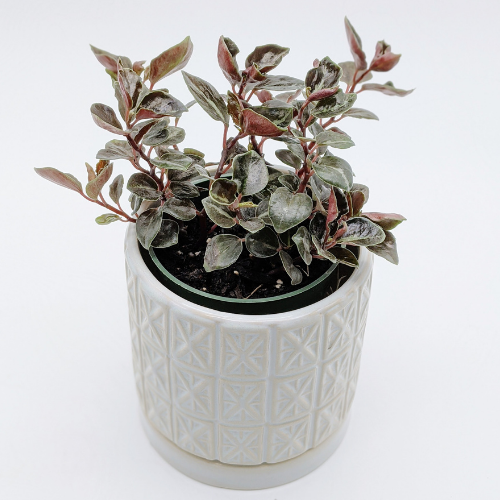Like most Peperomia, Red Tree Peperomia is one of the easier houseplants to care for. Tolerant of different levels of light and forgiving where watering is concerned, Red Tree Peperomia is great for the Plant Parent who has mastered philodendrons and is ready to level up to something a little more exotic looking, but still manageable.
Red Tree Peperomia, or Peperomia Metallica, is another showy member of the Piperaceae family. Its dark green and deep maroon foliage has a metallic sheen to it that is sure to catch the eye. This peperomia is rather compact, growing in a bush habit to around 8 inches in height. Red Tree Peperomia will not flower, but it is pet safe and is said to be air cleaning. Note, we assume it is pet safe because other peperomia are, but as this particular peperomia is still new, we’re not completely sure about some things. For that reason it’s best to avoid taking chances.

Red Tree Peperomia likes bright indirect light, but it will tolerate medium light as well. Red Tree Peperomia is slow growing, so don’t worry if you don’t see a lot of growth. Plant Red Tree Peperomia in a soil that will drain well and let the roots breathe – Orchid or African Violet soil are great options. This plant likes humidity, and for temperatures to be around 65-75 degrees Fahrenheit.
Any well-draining pot will do, just try to choose one with good drainage holes. Let the soil dry out about halfway before watering. You can also watch Red Tree Peperomia’s foliage for signs that it’s time to water – the leaves will begin to droop when it needs a drink. Use the “Drench and Drain” method to water. Allow the water to flow over the soil until the water runs out the bottom of the pot. Leave it running for a few minutes and then allow the excess water to drain. Never let a plant sit in soggy soil or in standing water. If your pot does not have drainage holes in the bottom, use a Moisture Meter to keep track of the moisture level before and during watering to avoid overwatering. If you do add too much water, tip the pot carefully to the side and allow excess water to gently drain out of the pot, but be careful to avoid spilling the soil.